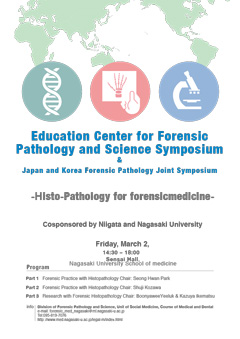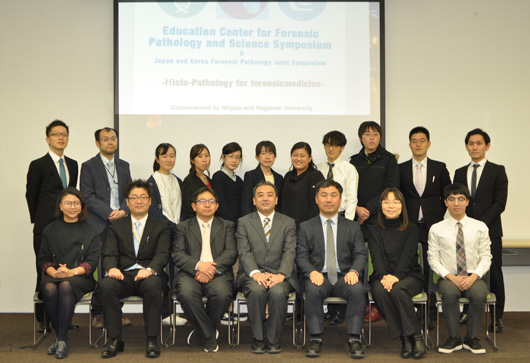 |
|
 |

 PDF-870KB PDF-870KB |
長崎大学医歯薬学総合研究科 死因究明医育成センターでは、2018年3月2日に「法医学実務に関する国際シンポジウム:International comparison of education for forensic medicine」を開催致します。
日本における法医学環境は様々な問題を内包していることは周知の事実かと思います。当センターでは法医学教育もその問題点の一つと考えており、特に法医実務に関連する法医病理学の分野では、その重要性にもかかわらず、人材育成も進んでいない現状があります。
今回の国際シンポジウムは、日本・韓国・タイの先生方の参加を頂くことができました。世界各地の法医病理学のの現状を招待講演者から学び、討論することで、法医病理学の実践や教育の問題点を探り、未来の法医学の向かうべき方向性や教育システムのあり方を明らかにしていきたいと考えています。 |
|
 |
| Symposium Program |
The Third Education Center for Forensic Pathology and Science Symposium
&
Japan and Korea Forensic Pathology Joint Symposium
-Histo-Pathology for forensic medicine-
Cosponsored by Niigata and Nagasaki University |
at Pompe van Meerdervoort Hall, Nagasaki University School of medicine
(Mar.2, 2018) |
 |
14:30-14:35
Opening Remarks
| |
Kazuya Ikematsu
Nagasaki University School of Medicine |
|
14:35-15:30
Part I: Forensic Practice with Histopathology
Chair: Seong Hwan Park
|
15:35-16:30
Part II: Forensic Practice with Histopathology
Chair: Shuji Kozawa
|
16:35-18:00
Part III: Research with Forensic Histopathology
Chair: Boonyawee Yeeluk & Kazuya Ikematsu
|
18:00-
Closing Remarks
| |
Seong Hwan Park
Department of Legal Medicine, Korea University College of Medicine |
|
|
 |
 |
My name is Wooyoung Jang, a 5th grade medical student in Korea University College of Medicine. As a 5th grader, I was in the polyclinic training course. But since there is no mandatory forensic medicine in this course, I always wanted to participate in any kind of forensic activities. Under this circumstance, invited to the symposium, I started studying for my presentation and then I had such great experiences and impressions. Attending in this symposium motivated me in many ways. Watching presentations, I got to know various fields of forensic medicine such as histopathology, molecular pathology and their methodologies in the context of forensic medicine. One of the cases introduced was very interesting for its uniqueness. (presentation 1: peliosis hepatis). and some experiments’ methods and tools were interesting such as those in presentation 6 and 7 (wound age estimation and drowning). After this enlightening experience, I came to think about career other than medical examiner, such as researcher in subspecialty of forensic medicine. Preparing my presentation, though it was a simple introduction of cases which I studied with, I learned pathologic knowledges more thoroughly than in my theoretic pathology course, which was in 3rd grade. Moreover, since I looked into social, medical past histories of the deceased, their diseases, macroscopic findings and histopathologic features sequentially, not only pathology but also outline of forensic medicine could be learned. This had been a great opportunity to learn in the actual context beyond the textbook. After this symposium, I also had great time to talk with medical students from Nagasaki University. Learning about Japan’s medical education programs and comparing with that of Korea’s was helpful to check my status (what I lacked and what I exceeded) and get inspirations. Also exchanging each others’ opinions on future career was valuable. I’d like to thank Professor Kazuya Ikematsu for inviting me in this symposium which had been a great experience.
|
|
 |
|
|
| |
|
|
 |

